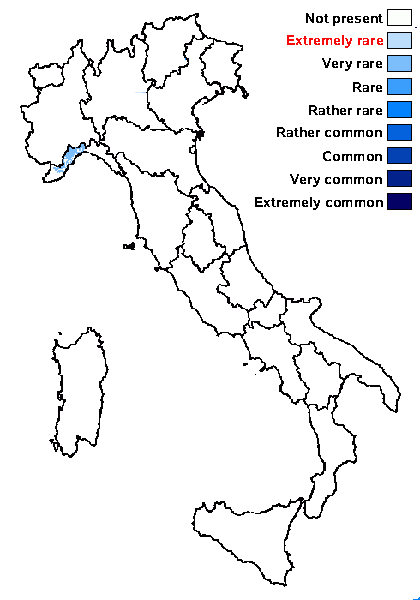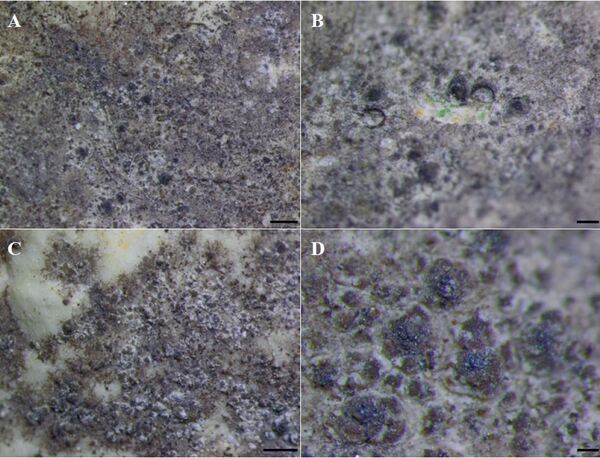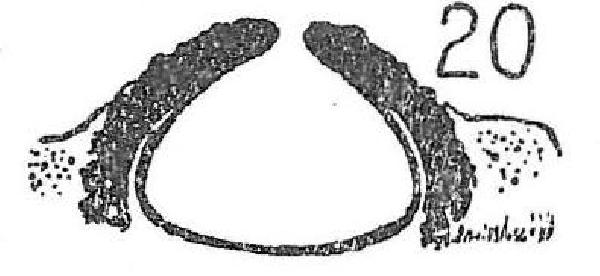Verrucaria bisagnoensis Servít
Sborn. Narodn. Mus Praze, 5, B, 9, bot. 3: 16, 1949.
Synonyms:
Distribution: N - Lig.
Description: Thallus crustose, thinly episubstratic, brown, subgelatinous when wet, of dispersed to dense granules or fleck-like, convex to flat areoles partly coalescing into an uneven crust, often developing in small depressions of the rock. Perithecia black, in shallow pits of the rock, hemispherically projecting. Involucrellum 70-90 μm thick, hemispherical, with a rough outer surface, adpressed to exciple, reaching down to base level; exciple subglobose, 0.15–0.2 mm across, the wall brown throughout; hamathecium of periphyses and periphysoids measuring 25-35 x 2-2.5 μm, interascal filaments absent; hymenial gel hemiamyloid, I+ red (I+ blue at very low concentrations of I), K/I+ blue. Asci 8-spored, clavate, I-, fissitunicate, the wall thickened above, with an ocular chamber, dehiscent by extrusion of an endotunica to form a delicate rostrum, Verrucaria-type. Ascospores 1-celled, hyaline, broadly ellipsoid, 18-26 x 13-15.5 μm. Photobiont chlorococcoid. Spot tests: K-, C-, KC-, P-, UV-. Chemistry: without lichen substances.Note: a long-forgotten species which was recently resurrected by Muchnik & Breuss (2015), present also in Slovenia and Russia. The type was collected in Val Bisagno near Genova, on sandstone, but material from Slovenia and Russia is on limestone.
Growth form: Crustose
Substrata: rocks
Photobiont: green algae other than Trentepohlia
Reproductive strategy: mainly sexual
Poorly known taxon in need of further study
Commonnes-rarity: (info)
Alpine belt: absent
Subalpine belt: absent
Oromediterranean belt: absent
Montane belt: absent
Submediterranean belt: very rare
Padanian area: absent
Humid submediterranean belt: absent
Humid mediterranean belt: absent
Dry mediterranean belt: very rare

Predictive model

Source: • Muchnik E.E., Breuss O. 2015. New and noteworthy records of Verrucariaceae (lichenised Ascomycota) from central European Russia. Herzogia, 28, 2, 2: 746-752.
A – habit of central part of thallus with fleck-like areoles and perithecia; B – detail
showing sectioned perithecia; C – margins of thallus; D – detail of perithecia (Muchnik s.n., 08.06.13, LI). Scales:
A, C – 500 μm, B – 200 μm, D – 100 μm.
Growth form: Crustose
Substrata: rocks
Photobiont: green algae other than Trentepohlia
Reproductive strategy: mainly sexual
Poorly known taxon in need of further study
Commonnes-rarity: (info)
Alpine belt: absent
Subalpine belt: absent
Oromediterranean belt: absent
Montane belt: absent
Submediterranean belt: very rare
Padanian area: absent
Humid submediterranean belt: absent
Humid mediterranean belt: absent
Dry mediterranean belt: very rare

Predictive model

 INDEX FUNGORUM
INDEX FUNGORUM
 GBIF
GBIF


